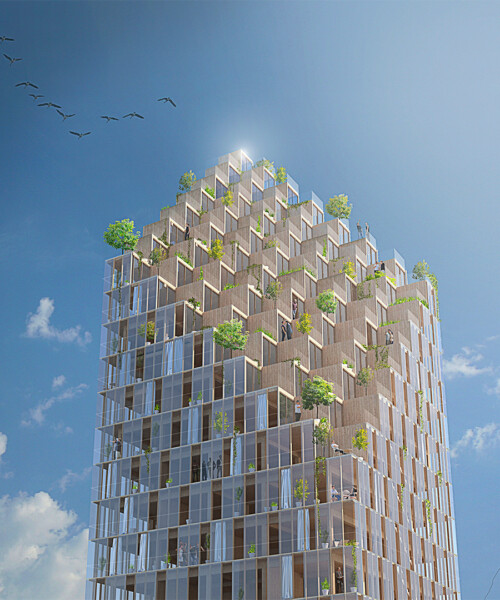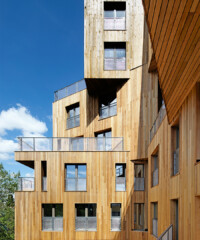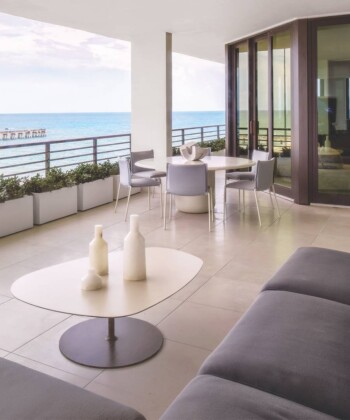The eco-friendly future of urban construction is here, and it looks a whole lot like an epic game of Jenga. In the last five years, 17 wood high-rises of seven stories or taller have been erected around the world, with at least a dozen even loftier projects currently in the works.
This summer, a 10-story residential building called The Cube was completed in London—just besting the city’s other wooden tower and former record holder, the nine-story Stadthaus, and inching out Melbourne’s 10-story Forté apartments. Not to be outdone, this December in Bergen, Norway, residents will begin moving into Treet tower, which at 14-stories is now the world’s tallest wooden building—for the time being. An 18-story high-rise has the green light in Vancouver; construction on a 24-story skyscraper is set to commence in Vienna next year; and a 34-story colossus will rise in Stockholm in 2023. The U.S. Department of Agriculture just awarded funds to the first tall timber developments stateside: residential buildings in Manhattan and Portland, Oregon—10 and 12 stories respectively.
The innovation that’s enabled these soaring heights is a relatively new wood product known as Cross Laminated Timber, or CLT, which is composed of individual layers glued together at 90-degree angles to form panels as thick as 20 inches and as long as 98 feet. CLT has the comparable strength of reinforced concrete slabs but is significantly lighter, which cuts costs by up to 50 percent due in part to highly expedited construction times and less expensive foundation work.
Beyond the financial benefits, the chief attraction of going vertical with wood is environmental. In the U.S., the construction industry is responsible for 47 percent of all CO2 emissions, compared to the 20 percent contributed by cars and trucks. By 2050, more than 70 percent of the world’s population is expected to be living in cities, but steel and concrete—the primary construction materials for urban buildings—account for 8 percent of all global carbon emissions. Wood, on the other hand, retains its carbon. Next year’s skyscraper in Vienna will save 2,800 metric tons in carbon emissions—the equivalent of taking 1,080 cars off the road for a year. Moreover, a greater demand for wood creates an economic incentive for planting more trees in deforested regions that would otherwise be charted for commercial agriculture. And responsible forestry certifications are increasingly pervasive—especially in North America, where studies have shown the continent’s forests grow enough wood for a 20-story building every eight to 10 minutes.
Of course, when it comes to 20-story buildings made of wood, the first concern is fire. But extensive studies have shown that CLT acts more like concrete than any logs you’d light at a campfire—at times even outperforming steel. If not coated properly with protective materials, steel melts when exposed to fire, whereas the density of CLT panels allows their outer layers to char slowly, insulating the wood within from damage. According to Vancouver-based architect Michael Green, false assumptions about flammability are one of the last things holding the wood revolution back.
“People just think, ‘That’s going to burn,’” says Green, who became the movement’s unofficial spokesperson after a popular TED Talk he gave on the subject in 2013. “But we have to make these buildings perform to such a high standard—actually, the exact same standard as steel and concrete buildings—that the risk of fire is actually extremely low.”
While computerized engineering has enabled large-scale dramatics never before thought possible in architecture, there is currently something of a disconnect between the industry’s commitment to sustainability and its celebration of bold-faced names like Frank Gehry, Santiago Calatrava and Jean Nouvel, whose designs demand extravagant funds and resources. Green argues that the outlandish angles and curves of contemporary architecture, which often require double the steel and concrete, can never be truly modern because of their disregard for the planet. “These buildings by the icons are pretty forms—if you were building a sculpture that sat on your desk,” he says. “But the global impact on the environment is horrendous. Truthfully, it’s like driving a Hummer; it’s the garbage of our industry. I think this is the beginning of the climate era of architecture, where we’ll have a different set of rules that define what modern should be.”













































